Last week in Nature, Ben Sanderson of CICERO in Oslo, Norway issued a challenge to the climate science community, calling for the Intergovernmental Panel on Climate Change (IPCC) to achieve net-zero emissions:
IPCC members should remember that nobody is better placed to demonstrate how to eliminate emissions. The IPCC’s actions matter, not just its words. Although it might make climate scientists uncomfortable, what the IPCC does about its own carbon emissions might be as crucial to its effectiveness as advancing cogent and robust science.
Sanderson makes an important point. After all, if the IPCC — a small organization with a modest budget — cannot actually go net-zero, then what chance is there for a world of 8 billion people with over $100 trillion in GDP?
Some propose that climate science might get to net-zero or even part of the way there through austerity, either by personal choice or imposed by governments. Commercial air travel provides a great example why this line of thinking is a distraction in climate policy.
The IPCC does most of its work through meetings and workshops, which is common across science. That means a lot of travel and especially a lot of international travel, as science is a global, collaborative endeavor. I’ve been fortunate in my career to have travelled all over the world, met incredible people, established productive collaborations and life-long friendships. My work has not just benefitted immeasurably from these experiences, but would have been impossible without them.
But travel also has a carbon cost, and some call for researchers to eliminate or limit travel to contribute to reducing emissions or to serve as a role model for the general public.
For instance, in 2019, Science reported on a number of climate scientists who advocated reducing their personal carbon footprints by flying less. One climate scientist said that she reduced her annual travel from 200,000 kilometers per year (equivalent to the annual total emissions of about 20 people at the global 50th percentile) to only 50,000 kilometers (~5 people).
But rather than indicating the potency of individual action by scientists to contribute to emissions reductions, this scientist’s reduction of flights illustrates a more fundamental reality — net-zero is not going to happen through austerity, either by choice or by fiat. If every person on the planet flew as much as this scientist after she reduced her flying then total flying globally would increase by 50x from 2023 (based on ~1,000 passenger-km per person globally in 2023).
Let’s take a look at some broader data.
Last week, @FlightRadar24 marked a milestone: “22,000 flights in the air right now, topping the most we’ve ever tracked at one time. Yesterday we tracked more than 253k flights, another new single day record.” You can see those flights below.

Those sorts of records are going to keep on coming.
The U.S. Energy Information Agency projects in its most recent International Energy Outlook that commercial air travel will nearly triple by 2050 from that of 2023, with significant growth in every region around the world, especially in the world’s two most populous countries, as you can see below.

An interesting study published last week in the Journal of Sustainable Tourism explored how travelers easily rationalize air travel, even when they know that it contributes carbon dioxide to the atmosphere. The study, which looked at travelers from Iceland, found that people are readily able to justify their air travel despite climate change. Individuals adopt “an elitist narrative based on social distinction.” In other words, people think — my flying is OK, it’s those others who are the problem.
The authors continue:
Flights used for the purposes of individualised travel aimed at delivering educational and meaningful experiences are contrasted with unjustified forms of travel associated both with mass tourism and status-oriented tourism.
Mass tourism presumably include those working class people flying to crowded beaches and to football matches. Status-oriented tourism would include those bazillionaires flying on private jets and presumably as well those in the front of the plane, kicking back in their lay-flat seats while sipping mimosas.
Of course, you know who else excuses their personal air travel using a similar rationale? Bill Gates — who justifies his extensive private jet travel as follows: “I buy the gold standard of funding Climeworks to do direct air capture that far exceeds my family's carbon footprint and I spend billions of dollars on climate innovation.” It turns out that when it comes to justifying travel, Gates is just like everyone else.
Air travel has become increasingly accessible around the world in recent decades, opening up travel possibilities to those for whom such experiences were previously out of reach. But accessibility to air travel remains highly inequitable in ways that mirror other types of global inequities, as you can see below.

The International Civil Aviation Organization estimates that, “world wide – 51% of the population lives within 100 km of an International Airport – and 74% live within 100 km of any kind of airport.” These numbers are going to change as air travel continues to expand, with more airports, more planes and more people taking to the skies. By 2050, at any given moment there may be more than 5 million people in the air around the world.
Countries around the world have recognized the reality that air travel will continue to grow, and 184 countries committed last year under the ICAO to achieving net-zero aviation by 2050.
How will that be achieved? According to ICAO, achievement of the goal:
“will rely on the combined effect of multiple CO2 emissions reduction measures, including the accelerated adoption of new and innovative aircraft technologies, streamlined flight operations, and the increased production and deployment of sustainable aviation fuels”
Let me translate: We’re not exactly sure, but we hope to figure it out.
That is also a good summary for achieving net-zero across the global economy. Not knowing is OK, and is actually the baseline state of long-term aspirational policy making. That’s is one reason why we need experts — to help us figure out what we might do in situations where we know where we want to go, but not exactly how we’ll get there.
How are we going to cure cancer? How is the Russia-Ukraine war going to end? How do we feed a world of 10 billion?
We’re not exactly sure, but we hope to figure it out.
And based on history, I’m optimistic that we will. Mass air travel is here to stay and so too are billionaires in private jets. The world is going to see a lot more travel in the future and that’s a good thing. Let’s get to work and deal with it.
Thanks for reading! If you like the content here, please share and like. This is a subscriber-supported endeavor and every subscriber at every level matters. I welcome your comments as well.





Frankly, Net Zero makes no sense. Our current path leads to diminishing T's sometime before 2100. We will continue to reduce CO2 emissions thru increasing efficiency (e.g., chemical process intensification), and tech evolution (e.g., small modular nuclear reactors). Sea levels will continue to rise no matter what; for many cities subduction is a much greater problem (e.g., NOLA, SE FL, Norfolk).
When you add in the very real negative impacts of trying to get there (e.g., poorer quality of life in the developed world, and stamping on the necks of the poor in the developing world), I'm left questioning the ethical foundations of those who want to "achieve" it.
Most in-person conferences are farces and boondoggles. They can easily be replaced by Zoom meetings or phone calls.